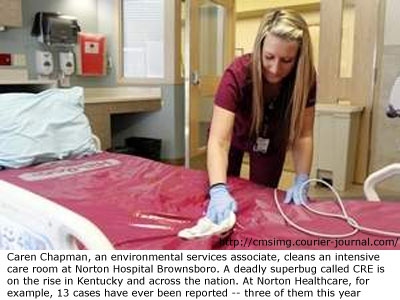 They’ve been called “nightmare bacteria” — deadly superbugs known as CRE that strike hospitalized patients and kill as many as half who get bloodstream infections.
They’ve been called “nightmare bacteria” — deadly superbugs known as CRE that strike hospitalized patients and kill as many as half who get bloodstream infections.
And they’re on the rise — in Louisville and across the nation.
The U.S. Centers for Disease Control and Prevention issued a strong warning this month, saying “action is needed now to stop these deadly infections” that have been treated in nearly 200 U.S. hospitals during the first half of 2012.
While neither Kentucky nor the federal government tracks individual cases, local hospitals officials say they’ve seen a growing number in recent years — and they’re enacting measures to combat CRE — short for carbapenem-resistant Enterobacteriaceae, a family of germs that has high resistance to antibiotics.
“If it gets in the community and spreads, we’re in trouble,” said Dr. Kevin Kavanagh, who leads the Somerset, Ky.-based watchdog group Health Watch USA.
University Hospital officials said they had a case this year in which the patient died, and Norton Healthcare says three of its 13 cases since 2010 have occurred this year, prompting Chief of Microbiology Alan Junkins to say, “I’m kind of worried it’s getting worse.”
“In my mind, this is one of the most worrisome (group of) germs we as a society have to deal with,” said Dr. Paul Schulz, Norton system epidemiologist. “You really get this combination of potentially high virulence and very difficult resistance” to antibiotics.
Experts say the problem is fueled by the overuse of antibiotics and gaps in infection control in hospitals and long-term care facilities — the same problems that give rise to other pernicious, health-care-associated infections such as MRSA and C. difficile (commonly called C. diff).
Officials at Norton and other facilities say they are taking steps to prevent infections — stressing measures such as hand-washing, room-cleaning and using antibiotics more wisely.
The Kentucky Department for Public Health, meanwhile, educates health care providers about preventing superbugs and will soon tap into CDC statistics on health-care-associated infections.
Source: courier-journal.com








